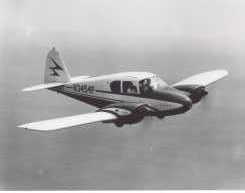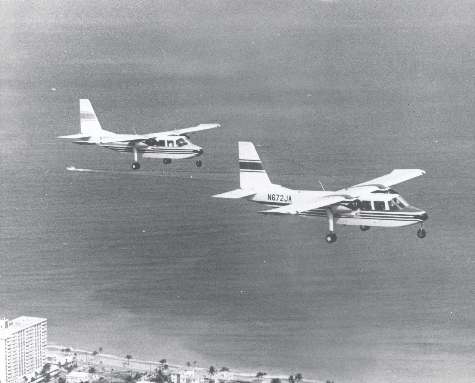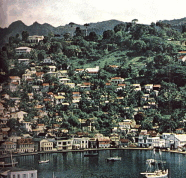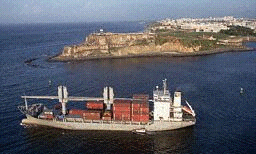|
Bending southward from this large island are the Leeward and Windward islands of the Caribbean. After leaving the gateway of San Juan these islands stand open before the traveler with their tall, verdant mountains, extinct  volcanoes and whitewashed port towns. Red roofed homes speckle the hillsides, and their shadows are translucent in the clear water of the bays. Winding roads cut through luscious jungles. Surrounding the islands are a halo of white beaches and turquoise waters. Several yachts lie idle, anchored in protective blue lagoons. L1011s constantly bring in another load of tourists
to sample the waters, fishing, beaches, clubs and calypso music. Inner island charters do for the rest: commuter prop liners, small jets or private planes. Sloops and yawls and sailing clippers are sampled by the more adventurous. volcanoes and whitewashed port towns. Red roofed homes speckle the hillsides, and their shadows are translucent in the clear water of the bays. Winding roads cut through luscious jungles. Surrounding the islands are a halo of white beaches and turquoise waters. Several yachts lie idle, anchored in protective blue lagoons. L1011s constantly bring in another load of tourists
to sample the waters, fishing, beaches, clubs and calypso music. Inner island charters do for the rest: commuter prop liners, small jets or private planes. Sloops and yawls and sailing clippers are sampled by the more adventurous.
The names of these islands are synonymous with tropical paradise: Anguilla, Antigua, Barbuda, Saint Vincent, Grenada, St. Kitts, St. Lucia, Martinique, Guadaloupe, Trinidad and Tobago, and Barbados.
Some of the most outstanding disappearances in this corner of the Triangle have occurred within these peaceful islands. But none of them  is as remarkable as that of the disappearance of a Piper Navajo. This inner island twin engine charter aircraft represents the closest time in all the history of the Triangle’s enigma that a disappearance is as remarkable as that of the disappearance of a Piper Navajo. This inner island twin engine charter aircraft represents the closest time in all the history of the Triangle’s enigma that a disappearance
|
The bulbous but ever reliable Piper Apache. Several have vanished, often with pilots that had chalked up thousands of flight hours experience.
|
was witnessed. It vanished while coming in for a landing at Harry S. Truman Airport on St. Thomas in 1978, suddenly gone as if plucked away by a vengeful or greedy hand.
 |
|
One of the most disturbing disappearances happened to a charter Piper Navajo here at St. Thomas. While on approach to the airport, the plane suddenly vanished, without trace and without any ELT. It was between Little Saba Island and the airport, and was, furthermore, being watched by the tower controller, William Kittinger.
|
|
Around St. Thomas, U.S. Virgin Islands, 3 aircraft have vanished after having signaled approach. In the above case, it happened between the tower operator’s glance out the  window at its running lights and his glance back at the radarscope which now was blank. window at its running lights and his glance back at the radarscope which now was blank.
Other disappearances have happened after briefly clutching safety. Such as a Twin Otter,
|
“Cleared to land St. Thomas. Failed to arrive. Presumed lost at sea.” Thus the fate of one Britten Norman-Islander was officially summed up, when it disappeared on Feb. 10, 1974. The same phenomenon repeated itself in 1978 and 1982.
|
which broke out of approach twice before it vanished on its last circumference of St. Vincent.
Many of these pilots were charter captains with thousands of hours flight experience. Pilot error seems far removed. Other seasoned pilots, who often have searched for the missing, are equally at a loss to explain such sudden loss, especially when it is without trace and so close to land.
Electronically, however, there should still be a trail, for modern private and commercial aircraft carry what is called an ELT— “Emergency Locator Transmitter.” It is an electronic device that jettisons from an aircraft when it impacts. Dozens have carried these handy devices, yet not one has ever left even this electronic SOS behind. It is not dependent on the human equation to operate; everything is automatic. Yet everything is wrong in these losses. They should
have left a trace, at least something, some signal, some shred of evidence. . . But nothing. when it impacts. Dozens have carried these handy devices, yet not one has ever left even this electronic SOS behind. It is not dependent on the human equation to operate; everything is automatic. Yet everything is wrong in these losses. They should
have left a trace, at least something, some signal, some shred of evidence. . . But nothing.  Always nothing! Always nothing!
On ships as well. The freighter El Caribe vanished in the Caribbean, without a sound from her automatic alarm. The pattern seems undeniable, whether from ships or planes, there is sudden, total and permanent silence. 
These nodal points are not all there is to the Triangle or its mysteries. We have only skimmed along the skin of the enigma. Within the Triangle there is the “damnable Sargasso Sea.”
|